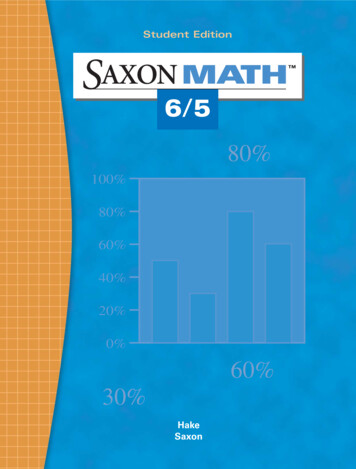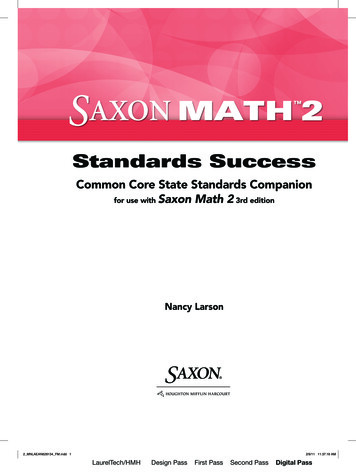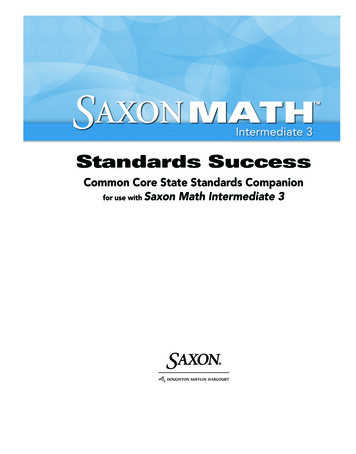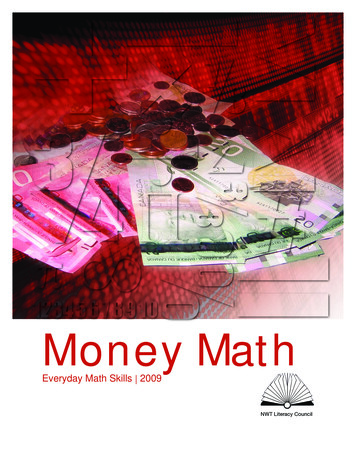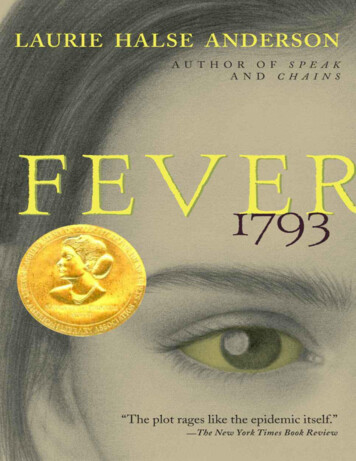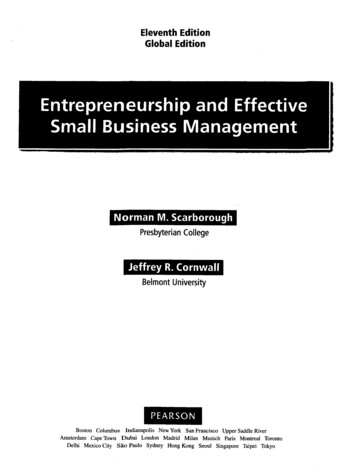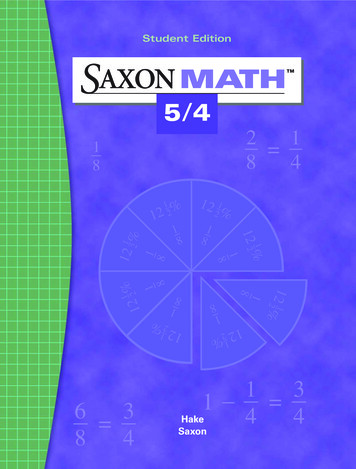
Transcription
Student EditionSAXON MATH 5/4c Fb121818%18121818181%12 21212121 122%18%12%18%12g H 121%12 2%21121–HakeSaxonF H
Student EditionStephen HakeJohn Saxon
Saxon Publishers gratefully acknowledges the contributions of the following individuals inthe completion of this project:Authors: Stephen Hake, John SaxonConsultants: Diane Blank, Shirley McQuade DavisEditorial: Chris Braun, Brian E. Rice, Mary Burleson, Matt Maloney, Sherri Little,Rodney Clint Keele, Bo Björn Johnson, Brian Smith, Brooke Butner, Dana Nixon,Andrew Kershen, Sean G. DouglasEditorial Support Services: Christopher Davey, Jay Allman, Susan Toth, Jean Van Vleck,Shelley Turner, Darlene C. TerryProduction: Adriana Maxwell, Karen Hammond, Brenda Lopez, Debra Sullivan, DianeReadnour, Donna Jarrel, Ryan LaCroix, Alicia Britt, Nancy Rimassa, Cristi D. WhiddonProject Management: Angela Johnson, Becky Cavnar 2004 Saxon Publishers, Inc., and Stephen HakeAll rights reserved. No part of Saxon Math 5/4, Third Edition, Student Edition maybe reproduced, stored in a retrieval system, or transmitted in any form or by any means,electronic, mechanical, photocopying, recording, or otherwise, without the prior writtenpermission of the publisher. Address inquiries to Editorial Support Services, SaxonPublishers, Inc., 2600 John Saxon Blvd., Norman, OK 73071.Printed in the United States of AmericaISBN: 1-56577-503-1Manufacturing Code: 03S0704
C O N T E N T SLetter from Author Stephen HakeAcknowledgmentsLESSON 1 Review of Addition Addition Stories xixii1Missing Addends, Part 1LESSON 2 Missing Addends, Part 26LESSON 3 Sequences Digits9LESSON 4 Place Value13LESSON 5 Ordinal Numbers Months of the Year17LESSON 6 Review of Subtraction Addition and21Subtraction Fact FamiliesLESSON 7 Writing Numbers Through 99924LESSON 8 Adding Money28LESSON 9 Adding with Regrouping31LESSON 10 Even Numbers Odd NumbersINVESTIGATION Number Lines35391LESSON 11 Addition Stories with Missing Addends45LESSON 12 Missing Numbers in Subtraction48LESSON 13 Adding Three-Digit Numbers52LESSON 14 Subtracting Two-Digit and Three-Digit Numbers 55Missing Two-Digit AddendsLESSON 15 Subtracting Two-Digit Numbers with Regrouping60LESSON 16 Expanded Form More on Missing Numbers64in SubtractionLESSON 17 Adding Columns of Numbers with Regrouping68LESSON 18 Reading Scales71LESSON 19 Reading Time from a Clock75LESSON 20 Rounding Numbers to the Nearest Ten 79Rounding Money to the Nearest DollarINVESTIGATION Units of Length Perimeter832v
viSaxon Math 5/4LESSON 21 Triangles, Rectangles, Squares, and Circles87LESSON 22 Naming Fractions Adding Dollars and Cents92LESSON 23 Lines, Segments, Rays, and Angles96LESSON 24 More About Missing Numbers in Addition102and SubtractionLESSON 25 Subtraction Stories106LESSON 26 Drawing Pictures of Fractions111LESSON 27 Multiplication as Repeated Addition 115Elapsed TimeLESSON 28 Multiplication Table119LESSON 29 Multiplication Facts (0’s, 1’s, 2’s, 5’s)124LESSON 30 Subtracting Three-Digit Numbers with Regrouping127INVESTIGATION Multiplication Patterns Area 1313 Squares and Square RootsLESSON 31 Word Problems About Comparing136LESSON 32 Multiplication Facts (9’s)141LESSON 33 Writing Numbers Through Hundred Millions,145Part 1LESSON 34 Writing Numbers Through Hundred Millions,151Part 2LESSON 35 Naming Mixed Numbers Two Forms of Money156LESSON 36 Fractions of a Dollar161LESSON 37 Reading Fractions and Mixed Numbers165from a Number LineLESSON 38 Multiplication Facts (Memory Group)169LESSON 39 Reading an Inch Scale to the Nearest Fourth172LESSON 40 Capacity176INVESTIGATION Decimal Numbers1814LESSON 41 Subtracting Across Zero Missing Factors189LESSON 42 Multiplying Multiples of 10 and 100 194Rounding Numbers to the Nearest HundredLESSON 43 Adding and Subtracting Decimal Numbers,199Part 1LESSON 44 Multiplying Two-Digit Numbers, Part 1203
ContentsLESSON 45 Parentheses Associative Property 206Naming Lines and SegmentsLESSON 46 Division212LESSON 47 Other Ways to Show Division216LESSON 48 Multiplying Two-Digit Numbers, Part 2220LESSON 49 Stories About Equal Groups, Part 1224LESSON 50 Adding and Subtracting Decimal Numbers,228Part 2INVESTIGATION Percents2325LESSON 51 Adding Numbers with More Than Three Digits 236Checking One-Digit DivisionLESSON 52 Subtracting Numbers with More Than Three240Digits Stories About Equal Groups, Part 2LESSON 53 One-Digit Division with a Remainder245LESSON 54 The Calendar 250Rounding Numbers to the Nearest ThousandLESSON 55 Multiples Factors255LESSON 56 Using Pictures to Compare Fractions260LESSON 57 Rate Word Problems264LESSON 58 Multiplying Three-Digit Numbers268LESSON 59 Estimating Arithmetic Answers272LESSON 60 Rate Problems with a Given Total276INVESTIGATION Displaying Data Using Graphs2806LESSON 61 Remaining Fraction Two-Step Equations286LESSON 62 Multiplying Three or More Factors Exponents290LESSON 63 Polygons294LESSON 64 Division with Two-Digit Answers, Part 1298LESSON 65 Divisor, Dividend, and Quotient 303Division with Two-Digit Answers, Part 2LESSON 66 Similar and Congruent Figures309LESSON 67 Multiplying by Multiples of 10313LESSON 68 Division with Two-Digit Answers and a Remainder318vii
viiiSaxon Math 5/4LESSON 69 Millimeters322LESSON 70 Stories About a Fraction of a Group327INVESTIGATION Collecting Data with Surveys3317LESSON 71 Division Answers Ending with Zero334LESSON 72 Finding Information to Solve Problems338LESSON 73 Geometric Transformations342LESSON 74 Fraction of a Set347LESSON 75 Measuring Turns351LESSON 76 Division with Three-Digit Answers 355Dividing MoneyLESSON 77 U.S. Customary Units of Weight 359Metric Units of MassLESSON 78 Classifying Triangles363LESSON 79 Symmetry367LESSON 80 Division with Zeros in Three-Digit Answers372INVESTIGATION Graphing Relationships3768LESSON 81 Angle Measures379LESSON 82 Tessellations384LESSON 83 Sales Tax Change Back388LESSON 84 Decimal Numbers to Thousandths392LESSON 85 Multiplying by 10, by 100, and by 1000396LESSON 86 Multiplying Round Numbers Mentally400LESSON 87 Multiplying Two Two-Digit Numbers, Part 1404LESSON 88 Remainders in Stories About Equal Groups408LESSON 89 Mixed Numbers and Improper Fractions412LESSON 90 Multiplying Two Two-Digit Numbers, Part 2415INVESTIGATION Investigating Fractions with Manipulatives4199LESSON 91 Decimal Place Value424LESSON 92 Classifying Quadrilaterals429LESSON 93 Estimating Multiplication and Division Answers433
ContentsLESSON 94 Two-Step Word Problems437LESSON 95 Two-Step Problems About a Fraction of a Group441LESSON 96 Average445LESSON 97 Mean Median Range Mode449LESSON 98 Geometric Solids453LESSON 99 Decimal Numbers and Money458LESSON 100 Constructing Geometric Models462INVESTIGATION Probability46610LESSON 101 Tables Schedules470LESSON 102 Decimal Number Line: Tenths and Hundredths474LESSON 103 Fractions Equal to 1 Fractions Equal to A479LESSON 104 Changing Improper Fractions to Whole484or Mixed NumbersLESSON 105 Dividing by 10488LESSON 106 Evaluating Expressions492LESSON 107 Adding and Subtracting Fractions with495Common DenominatorsLESSON 108 Formulas Distributive Property499LESSON 109 Equivalent Fractions504LESSON 110 Dividing by Multiples of 10509INVESTIGATION Volume51311LESSON 111 Estimating Area517LESSON 112 Reducing Fractions521LESSON 113 Multiplying a Three-Digit Number by a525Two-Digit NumberLESSON 114 Simplifying Fraction Answers529LESSON 115 Renaming Fractions533LESSON 116 Common Denominators537LESSON 117 Rounding Whole Numbers Through541Hundred MillionsLESSON 118 Dividing by Two-Digit Numbers545ix
xSaxon Math 5/4LESSON 119 Adding and Subtracting Fractions with549Different DenominatorsLESSON 120 Adding and Subtracting Mixed Numbers with552Different DenominatorsINVESTIGATION Solving Equations55612TOPIC A Using Money Manipulatives to Represent561Decimal Place ValueTOPIC B Roman Numerals Through 39563TOPIC C Roman Numerals Through Thousands565TOPIC D Base 5566Supplemental Practice Problems forSelected Lessons569Glossary585Index611
LETTER FROM AUTHOR STEPHEN HAKEDear Student,We study mathematics because of its importance to our lives. Ourschool schedule, our trip to the store, the preparation of our meals,and many of the games we play involve mathematics. You willfind that the word problems in this book are often drawn fromeveryday experiences.As you grow into adulthood, mathematics will become even moreimportant. In fact, your future in the adult world may depend onthe mathematics you have learned. This book was written to helpyou learn mathematics and to learn it well. For this to happen, youmust use the book properly. As you work through the pages, youwill see that similar problems are presented over and over again.Solving each problem day after day is the secret to success.Your book is made up of daily lessons and investigations. Eachlesson has four parts. The first part is a Warm-Up that includespractice of basic facts and mental math. These exercises improveyour speed, accuracy, and ability to do math “in your head.” TheWarm-Up also includes a problem-solving exercise to familiarizeyou with strategies for solving complicated problems. The secondpart of the lesson is the New Concept. This section introduces anew mathematical concept and presents examples that use theconcept. In the next section, the Lesson Practice, you have achance to solve problems involving the new concept. Theproblems are lettered a, b, c, and so on. The final part of the lessonis the Mixed Practice. This problem set reviews previously taughtconcepts and prepares you for concepts that will be taught in laterlessons. Solving these problems helps you remember skills andconcepts for a long time.Investigations are variations of the daily lesson. The investigationsin this book often involve activities that fill an entire class period.Investigations contain their own set of questions instead of aproblem set.Remember, solve every problem in every practice set, everyproblem set, and every investigation. Do not skip problems.With honest effort, you will experience success and truelearning that will stay with you and serve you well in the future.Stephen HakeTemple City, Californiaxi
ACKNOWLEDGMENTSI wish to acknowledge the following contributors to the revision of SaxonMath 5/4–8/7:Barbara Place, who conceived the project.Dr. Gerald Beer, who provided lesson content and problems on topics ofpattern recognition, functions, scale drawings and models, probability, dataanalysis, and problem solving.Shirley McQuade Davis, for her ideas on teaching story-problem thinkingpatterns.Brian Rice, for his conceptual work on story-problem lessons and for hiseditorial work on the Assessments and Classroom Masters.Dan Shippey, who designed the Mercury Freedom 7 scale model for SaxonMath 7/6, Investigation 11.Mary Burleson, who scheduled the project and coordinated efforts among themany participants.Adriana Maxwell, who coordinated the production of the manuscripts.Diane Blank, for her extensive and thorough analysis of state standards andnumerous helpful suggestions for addressing those standards.Nancy Crisler, for her contributions to the Teacher’s Manuals.Nancy Larson, for her generous help and insightful suggestions for theTeacher’s Manuals.Chris Braun, whose invaluable contributions as senior editor span the contentsof the series.John Saxon, whose unwavering focus on student success continues to inspireand guide.Mary Hake, for her support, encouragement, and patience.Stephen HakeTemple City, Californiaxii
L E S S O N1Review of Addition AdditionStories Missing Addends, Part 1WARM-UPFacts Practice: 100 Addition Facts (Test A)†Mental Math:Add ten to a number:a.b.20 1034 10c.e. 25 10d. 5 1010 53f. 10 8Patterns:As a class, count by twos from 2 through 40 while the teacher ora student lists the numbers in a column on the board. Study thelist. Which digits appear as final digits? Which digits do notappear as final digits?NEW CONCEPTSReview of Addition is the combining of two groups into one group. Foraddition example, when we count the dots on the top faces of a pair ofdot cubes (dice), we are adding.† 4 3 7The numbers that are added are called addends. The answeris called the sum. The expression 4 3 7 is a numbersentence. A number sentence is a complete sentence that usesnumbers and symbols instead of words. Here we show twoways to add 4 and 3:4 37addendaddendsum3 47addendaddendsum†For instructions on how to use the Warm-up activities, please consult thepreface.1
2Saxon Math 5/4Notice that if the order of the addends is changed, the sumremains the same. This property of addition is true for any twonumbers and is called the commutative property of addition.When we add two numbers, either number may be first.4 3 73 4 7When we add zero to a number, the number is not changed.This property of addition is called the identity property ofaddition. If we start with a number and add zero, the sum isidentical to the starting number.4 0 49 0 90 7 7Example 1 Write a number sentence for this picture:Solution A number sentence for the picture is 4 5 9. The numbersentence 5 4 9 is also correct.When adding three numbers, the numbers may be added inany order. Here we show six ways to add 4, 3, and 5. Eachway the answer is 12.43 51245 31234 51235 41254 31253 412Example 2 Show six ways to add 1, 2, and 3.Solution We can form two number sentences that begin with theaddend 1.1 2 3 61 3 2 6We can form two number sentences that begin with theaddend 2.2 1 3 62 3 1 6We can form two number sentences that begin with theaddend 3.3 1 2 63 2 1 6Addition Many word problems tell a story. Some stories are aboutstories putting things together. Look at this story:John had 5 marbles. He bought 7 more marbles.Now John has 12 marbles.
Lesson 13There is a pattern to this story. John had some marbles. Thenhe bought some more marbles. When he put the marblestogether, he found the total number of marbles. “Some andsome more” stories like this have an addition pattern.PROBLEM5 marbles 7 marbles12 marblesPATTERNSome Some moreTotalHere we show the pattern written sideways.PAT TERN: Some some more totalPROBLEM: 5 marbles 7 marbles 12 marblesHere we show a diagram for the story:SomefiMore‡Total is .Example 3 Miguel saw 8 ducks. Then he saw 7 more ducks. How manyducks did Miguel see in all?Solution This problem follows the idea of “some and some more.” Weshow the addition pattern below.PAT TERN: Some some more totalPROBLEM: 8 ducks 7 ducks 15 ducksWe find the total number by adding 8 and 7. Miguel saw15 ducks in all.Example 4 Samantha saw rabbits in the field. She saw 5 rabbits in the eastfield. She saw 3 rabbits in the west field. She saw 4 rabbits inthe north field. How many rabbits did Samantha see in all?Solution In this story there are three addends.PATTERNSomeSome more Some moreTotalSamantha saw 12 rabbits in all.PROBLEM5 rabbits3 rabbits 4 rabbits12 rabbits
4Saxon Math 5/4Missing Some of the problems in this book will have an addendaddends, missing. When one addend is missing and the sum is given,part 1 the problem is to find the missing addend. Can you figure outthe missing addend in this number sentence? 2 ? 7Since we know that 2 5 7, the missing addend is 5. Wewill often use a letter to represent a missing number, as wesee in the example below.Example 5 Find each missing addend:(a)4 N7(b) B 6 10Solution (a) The letter N stands for a missing addend. Since4 3 7, the letter N stands for the number 3 in thisnumber sentence.(b) In this problem the letter B is used to stand for themissing addend. Since 4 6 10, the letter B standsfor the number 4.LESSON PRACTICEPractice set Add:a. 5 6b. 6 5d. 4 8 6c. 8 0e. 4 5 6f. Diane ran 5 laps in the morning. She ran 8 laps in theafternoon. How many laps did she run in all?g. Write two number sentences for thispicture to show the commutativeproperty:h. Show six ways to add 1, 3, and 5.Find each missing addend:i. 7 N 10j. A 8 12
Lesson 15MIXED PRACTICEProblem set1. There were 5 students in the first row and 7 students inthe second row. How many students were in the firsttwo rows?2. Ling had 6 coins in her left pocket and 3 coins in her rightpocket. How many coins did Ling have in both pockets?Find each sum or missing addend:3. 9 44. 8 25.4 N96.W7. 586 P89. 3 4 510. 4 4 411. 6 R 1012. X 5 613.17.55 5M 9108.Q 8814.80 715.65 416.99 918.919.Z20.0 F12 510 N321. 3 2 5 4 622. 2 2 2 2 2 2 2Write a number sentence for each picture:23.24.25. Show six ways to add 2, 3, and 4.26. Sometimes a missing number is shown by a shapeinstead of a letter. Choose the correct number for in thefollowing number sentence: 3 10A. 3B. 7C. 10D. 13
6Saxon Math 5/4L E S S O N2Missing Addends, Part 2WARM-UPFacts Practice: 100 Addition Facts (Test A)Mental Math:Add ten to a number:a. 40 10d. 7 10c. 39 10f. 10 63b. 26 10e. 10 9Patterns:As a class, count by fives from 5 to 100 while the teacher or astudent lists the numbers in a column on the board. Which digitsappear as final digits? Which numbers in the list are numbers wesay when we count by twos from 2 to 100?NEW CONCEPTDerek rolled a dot cube three times. The picture below showsthe top face of the cube for the first two rolls.First rollSecond rollThe total number of dots on all three rolls was 12. Can youdraw a picture of Derek’s third roll?We will write a number sentence for this problem. Thef irst two numbers are 5 and 3. We do not know the numberof the third roll, so we will use a letter. We know that thetotal is 12.5 3 T 12To find the missing addend, we first add 5 and 3, whichmakes 8. Then we think, “Eight plus what number equalstwelve?” Since 8 plus 4 equals 12, the third roll was .
Lesson 27Example Find each missing addend:(a)(b) 4 3 2 B 6 206N 517Solution (a) We add 6 and 5, which makes 11. We think, “Eleven pluswhat number equals seventeen?” Since 11 plus 6 equals 17,the missing addend is 6.(b) First we add 4, 3, 2, and 6, which equals 15. Since 15 plus5 is 20, the missing addend is 5.LESSON PRACTICEPractice set Find each missing addend:a. 8 A 2 17b. B 6 5 12c. 4 C 2 3 5 20MIXED PRACTICEProblem set†1. Hoppy ate 5 carrots in the morning and 6 carrots in the(1)afternoon. How many carrots did Hoppy eat in all?2. Five friends rode their bikes from the school to the lake.(1)They rode 7 miles, then rested. They still had 4 miles togo. How many miles was it from the school to the lake?Find each sum or missing addend:3. 9 N 134. 7 8(1)(1)5.(1)†P6. 613(2)52 W127.(1)48 58.(1)93 7The italicized numbers within parentheses underneath each problem numberare called lesson reference numbers. These numbers refer to the lesson(s) inwhich the major concept of that particular problem is introduced. If additionalassistance is needed, refer to the discussion, examples, or practice problems ofthat lesson.
8Saxon Math 5/49.810.(2)B(1) 31613.(1)17.(2)95 314.5318. T10(2)97 311.(1)215.M(2) 49(1)29 612.5316.(1)219.(2)X 71123(2) Q984 638 2 R720.(1)52 621. 5 5 6 4 X 23(2)22. Show six ways to add 4, 5, and 6.(1)Write a number sentence for each picture:23.24.(1)(1)25.(1)26. Which number is ó in the following number sentence?(1)6 ó 10A. 4B. 6C. 10D. 16
Lesson 39L E S S O N3Sequences DigitsWARM-UPFacts Practice: 100 Addition Facts (Test A)Mental Math:Add ten, twenty, or thirty to a number:a.b.20 2023 20c.43 10d.24 30e.50 30f.10 65g. One less than 24 is 23. What number is one less than 36? . oneless than 43? . one less than 65?Vocabulary:Copy these two patterns on a piece of paper. In each of the sixboxes, write either “addend” or “sum.” NEW CONCEPTSSequences Counting is a math skill we learn early in life. Counting byones, we say “one, two, three, four, five, .”1, 2, 3, 4, 5, These numbers are called counting numbers. The countingnumbers continue without end. We may also count bynumbers other than one.Counting by twos: 2, 4, 6, 8, 10, Counting by fives: 5, 10, 15, 20, 25, These are examples of counting patterns. A counting pattern isa sequence. The three dots mean that the sequence continueswithout end. A counting sequence may count up or countdown. We can study a counting sequence to discover a rule forthe sequence. Then we can find more numbers in the sequence.
10Saxon Math 5/4Example 1 Find the rule and the next three numbers of this countingsequence:10, 20, 30, 40, , , , Solution The rule is count up by tens. Counting this way, we find thatthe next three numbers are 50, 60, and 70.Example 2 Find the rule of this counting sequence. Then find themissing number in the sequence.30, 27, 24, 21, , 15, Solution The rule is count down by threes. If we count down threefrom 21, we find that the missing number in the sequenceis 18. We see that 15 is three less than 18, which followsthe rule.Digits To write numbers, we use digits. Digits are the numerals 0, 1,2, 3, 4, 5, 6, 7, 8, and 9. The number 356 has three digits, andthe last digit is 6. The number 67,896,094 has eight digits,and the last digit is 4.Example 3 The number 64,000 has how many digits?Solution The number 64,000 has five digits.Example 4 What is the last digit of 2001?Solution The last digit of 2001 is 1.LESSON PRACTICEPractice set Write the rule and the next three numbers of each countingsequence:a. 10, 9, 8, 7, , , , b. 3, 6, 9, 12, , , , Find the missing number in each counting sequence:c. 80, 70, , 50, d. 8, , 16, 20, 24, How many digits are in each number?f. 5280e. 18g. 8,403,227,189What is the last digit of each number?i. 5281h. 19j. 8,403,190
Lesson 311MIXED PRACTICEProblem set1. Blanca has 5 dollars, Susan has 6 dollars, and Britt has(1)7 dollars. Altogether, how much money do the threegirls have?2. On William’s favorite CD there are 9 songs. On his next(1)favorite CD there are 8 songs. Altogether, how many songsare on William’s two favorite CDs?3. How many digits are in each number?(3)(a) 593(b) 180(c) 186,527,3944. What is the last digit of each number?(3)(a) 3427(b) 460(c) 437,269Find each missing addend:5. 5 M 4 126. 8 2 W 16(2)(2)Write the next number in each counting sequence:7. 10, 20, 30, , 8. 22, 21, 20, , (3)(3)9. 40, 35, 30, 25, , (3)10. 70, 80, 90, , (3)Write the rule and the next three numbers of each countingsequence:11. 6, 12, 18, , , , (3)12. 3, 6, 9, , , , (3)13. 4, 8, 12, , , , (3)14. 45, 36, 27, , , , (3)Find the missing number in each counting sequence:15. 8, 12, , 20, (3)17. 30, 25, , 15, (3)16. 12, 18, , 30, (3)18. 6, 9, , 15, (3)
12Saxon Math 5/419. How many small rectangles are(3)shown? Count by twos.20. How many X’s are shown? Count(3)by fours.21. Write a number sentence for the picture below.(1)22.(1)487 523.(1)957 824.(1)847 225.(1)297 526. If 3 and ó 4, then ó equals which of the(1)following?A. 3B. 4C. 5D. 7
Lesson 413L E S S O N4Place ValueWARM-UPFacts Practice: 100 Addition Facts (Test A)Mental Math:Add ten, twenty, or thirty to a number:a. 66 10b. 29 20c. 10 76e. 20 6f . 40 30d. 38 30g. What number is one less than 76? . than 49? . than 68?Problem Solving:Tom has a total of nine coins in his left andright pockets. Copy and complete this tablelisting the possible number of coins in eachpocket. Your table should have ten rows ofnumbers.Number of CoinsLeft012Right9NEW CONCEPTTo help us with the idea of place value, we will use picturesto show different amounts of money. We will use 100 bills, 10 bills, and 1 bills.Example 1 How much money is shown in the picture below?Solution Since there are 2 hundreds, 4 tens, and 3 ones, the amount ofmoney shown is 243.Example 2 Use money manipulatives or draw a diagram to show how tomake 324 with 100 bills, 10 bills, and 1 bills.
14Saxon Math 5/4Solution To show 324, we use 3 hundreds, 2 tens, and 4 ones.3 hundreds2 tens4 onesThe value of each place is determined by its position. Threedigit numbers like 324 occupy three different places.ones placetens placehundreds place3 2 4Example 3 Use money manipulatives or draw a diagram to show both 203 and 230. Which is the greater amount of money, 203 or 230?Solution Using bills, we show 203 and 230 like this: 203 230The amount 230 is greater than 203.Example 4 The digit 7 is in what place in 753?Solution The 7 is in the third place from the right, which shows thenumber of hundreds. So the 7 is in the hundreds place.LESSON PRACTICEPractice seta. Use money manipulatives or draw a diagram to show 231 in 100 bills, 10 bills, and 1 bills.b. Use money manipulatives or draw a diagram to show 213. Which is less, 231 or 213?c. The digit 6 is in what place in each of these numbers?(a) 16(b) 65(c) 623d. Use three digits to write a number equal to 5 hundreds,2 tens, and 3 ones.
Lesson 415MIXED PRACTICEProblem set1. When Robert looked at the cards in his hand, he saw 3 clubs,(1)4 diamonds, 5 spades, and 1 heart. How many cards did hehave in all?2. Write a number sentence for this(1)picture:3. How many cents are in 4 nickels? Count by fives.(3)5 5 5 5 Find each sum or missing addend:5.6.4.4413(1)(1)(1)5 N Y 312197.(1)8. 4 N 5 129. N 2 3 8(2)(2)7 S14Write the rule and the next three numbers of each countingsequence:10. 9, 12, 15, , , , (3)11. 30, 24, 18, , , , (3)12. 12, 16, 20, , , , (3)13. 35, 28, 21, , , , (3)14. How many digits are in each number?(3)(a) 37,432(b) 5,934,286(c) 453,00015. What is the last digit of each number?(3)(b) 347(c) 473(a) 73416. Draw a diagram to show 342 in 100 bills, 10 bills, and(4) 1 bills.17. How much money is shown by this picture?(4)
16Saxon Math 5/4Find the missing number in each counting sequence:18. 24, , 36, 42, 19. 36, 32, , 24, (3)(3)20. How many ears are on 10 rabbits? Count by twos.(3)21. The digit 6 is in what place in 365?(4)22. Write a number sentence for this(1)picture:Find each missing addend:23. 2 5 3 2 3 1 N 20(2)24. 4 B 3 2 5 4 1 25(2)25. Show six ways to add 6, 7, and 8.(1)26. In the number 123, which digit shows the number of(4)hundreds?A. 1B. 2C. 3D. 4
17Lesson 5L E S S O N5Ordinal Numbers Months of the YearWARM-UPFacts Practice: 100 Addition Facts (Test A)Mental Math:Add a number ending in zero to another number:a.24 60b.36 10c.50 42d.33 30e.40 50f. What number is one less than 28? . 87? . 54?Patterns:Copy this design of ten circles on a pieceof paper. In each circle, write a countingnumber from 1 to 10 that continues thepattern of “1, skip, skip, 2, skip, skip, 3, .”123NEW CONCEPTSOrdinal If we want to count the number of children in a line, we say,numbers “one, two, three, four, .” These numbers tell us how manychildren we have counted. To describe a child’s position in aline, we use words like first, second, third, and fourth.Numbers that tell position or order are called ordinal numbers.Example 1 There are ten children in the lunch line. Pedro is fourth inline. (a) How many children are in front of Pedro? (b) Howmany children are behind him?Solution A diagram may help us understand the problem. We drawand label a diagram using the information given to us.Pedroin frontfourthbehind(a) Since Pedro is fourth in line, we see that there arethree children in f ront of him.(b) The rest of the children are behind Pedro. From thediagram, we see that there are six children behind him.
18Saxon Math 5/4Many times ordinal numbers are abbreviated. The abbreviationconsists of a counting number and the letters st, nd, rd, or th.Here we show some twenty-first21stExample 2 Andy is 13th in line. Kobe is 3rd in line. How many studentsare between Kobe and Andy?Solution We begin by drawing a diagram.KobeAndythirdthirteenthFrom the diagram we see that there are nine students betweenKobe and Andy.Months of We use ordinal numbers to describe the months of the yearthe year and the days of each month. This table lists the twelvemonths of the year in order. A common year is 365 days long.A leap year is 366 days long. The extra day in a leap year isadded to eventhtwelfthDAYS3128 or 2931303130313130313031
Lesson 519When writing dates, we can use numbers to represent themonth, day, and year. For example, if Robert was born on thesecond day of June in 1988, then he could write his birth datethis way:6/2/1988The form for this date is “month/day/year.” The 6 stands forthe sixth month, which is June, and the 2 stands for thesecond day of the month.Example 3 Jenny wrote her birth date as 7/8/89. (a) In what month wasJenny born? (b) In what year was she born?Solution (a) In the United States we usually write the number of themonth f irst. The f irst number Jenny wrote was 7. She wasborn in the seventh month, which is July.(b) When confusion is unlikely, we often abbreviate years byusing only the last two digits of the year. So we assumethat Jenny was born in 1989.Example 4 Mr. Chitsey’s driver’s license expired on 4/29/03. Write thatdate using the name of the month and all four digits of the year.Solution The fourth month is April. The year 03 represents 2003. SoMr. Chitsey’s license expired on April 29, 2003.LESSON PRACTICEPractice seta. Kiyoko was third in line, and Kayla was eighth in line.How many people were between them?b. Write your birth date in month/day/year form.c. In month/day/year form, wr
Saxon Math 5/4, Third Edition, Student Edition may be reproduced, stored in a retrieval system, or transmitted in any form or by any means, electronic, mechanical, photocopying, recording, or otherwise, without the prior written permission of the publisher. Address inquir
